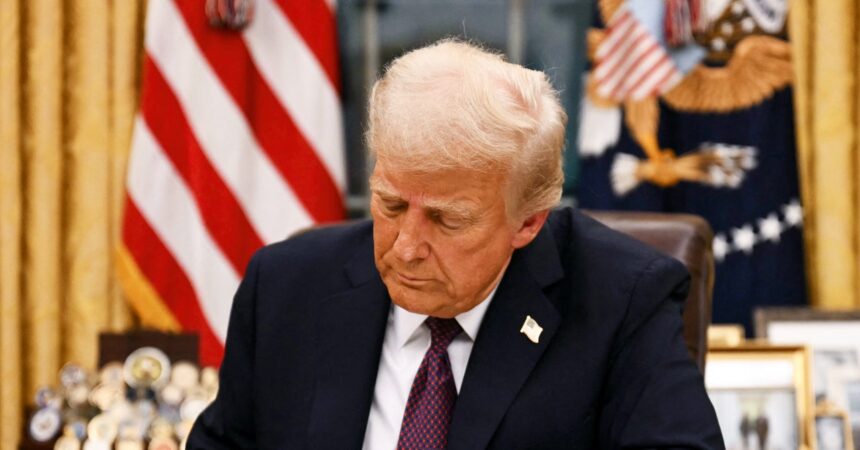Highlighting a specific executive order from Donald Trump’s extensive first-day directives feels akin to isolating a single bullet from a flurry fired from an AK-47. Yet, one of those orders struck me particularly hard. This order is “Establishing and Implementing the President’s Department of Government Efficiency.” The acronym, DOGE (inspired by a popular memecoin), refers to the initiative led by Elon Musk aiming to reduce government expenditure by one to two trillion dollars. Up until this week, DOGE was presented as an external entity, but now it has been formalized as a part of the government by integrating it into an existing agency that was previously associated with the Office of Management and Budget, known as the United States Digital Service. This agency will now be referred to as the US DOGE Service, and its new leader will have a more direct connection to the president, reporting to his chief of staff.
The revised USDS seems poised to divert its previous sharp focus on creating cost-effective and well-crafted software for various agencies towards a rigorous implementation of Musk’s ambitious vision. This transformation resembles a governmental version of a Special Purpose Acquisition Company (SPAC), a financially questionable strategy that brought Truth Social to the public market without the necessity of presenting a coherent business plan to investors.
The executive order is surprising in some ways since DOGE, on the surface, appears to be more modest than its initial grand proposal. This new phase seems more concentrated on achieving savings by streamlining and modernizing the sprawling and complicated IT frameworks of the government. Potential cost-cutting is certainly on the table, though likely falling significantly shy of trillions. It remains to be seen whether Musk will take on the role of DOGE administrator; this endeavor may not be ambitious enough for him. (Former USDS director Mikey Dickerson humorously noted on LinkedIn, “I’d like to congratulate Elon Musk on being promoted to my old job.”) However, reports indicate Musk advocated for this new structure as a means to root DOGE deeper within the White House. Inside the Executive Office Building, numerous pink Post-it notes are reportedly claiming territory beyond the former USDS domain, including one in the coveted office of the former chief information officers. Thus, this could serve as a launching pad for a broader initiative that would dismantle entire agencies and reshape policy. (I was unable to obtain a response from a White House representative, which is unsurprising given that countless other orders also warrant explanation.)
One thing is undeniably clear—this signifies the end of the United States Digital Service as it once operated and ushers in a new, potentially risky chapter for the USDS, which I have been keenly following since its establishment. This 11-year-old agency emerged from the tech-savvy rescue team that salvaged the disastrous Healthcare.gov website, which nearly derailed the Affordable Care Act. That courageous group of volunteers set the precedent for the agency: a compact team of engineers and designers who employed modern internet methodologies (favoring cloud solutions over mainframe systems, and opting for the agile programming approach instead of the antiquated waterfall method) to make government technology comparable to the applications people utilize on their smartphones. Its personnel, often transitioning from lucrative roles in Silicon Valley, were attracted by the promise of public service. They operated from the agency’s eclectic brownstone headquarters located on Jackson Place, just north of the White House. The USDS typically tackled projects that were bogged down by multimillion-dollar contracts and left unfinished, consistently delivering outstanding results in mere weeks. Their approach involved embedding staff within requesting agencies, ensuring close collaboration with long-standing IT department members. A typical engagement might have involved making Department of Defense medical records compatible with various systems used by the Veterans Affairs department. The USDS became a favorite of the Obama administration, emblematic of its alignment with cutting-edge technological culture.
During the initial Trump administration, astute political maneuvers helped keep the USDS viable, marking it as one of the rare Obama-era initiatives to survive. Its deputy director, Haley Van Dyck, skillfully garnered support from Trump’s internal fixer, Jared Kushner. When I met Kushner for an informal discussion early in 2017, I crossed paths with Van Dyck in the West Wing; she signaled that there was hope, at least momentarily. Nevertheless, the four years under Trump became a balancing act of showcasing the agency’s successes while remaining largely under the radar. “At Disney parks, they use a certain shade of green to paint things they wish to keep out of sight,” one USDSer shared. “We specialized in using that shade of green.” When the pandemic struck, this endeavor in invisibility became crucial, as the USDS collaborated closely with White House coronavirus response lead Deborah Birx on collating statistics—some of which the administration was reluctant to disclose.
By the conclusion of Trump’s tenure, the camouflage was beginning to fade. A source indicated that a Trump political appointee became displeased after noticing that USDS was actively recruiting at tech conferences targeting lesbians and minorities, inquiring why such a focus was necessary. The rationale was that this was an effective strategy for locating exceptional product managers and designers. The appointee accepted this, albeit suggesting that instead of listing “Lesbians Who Tech” on expense reports, they could simplify it to LWT.










